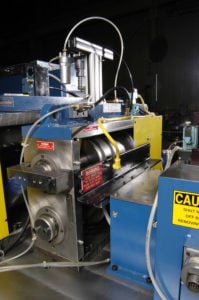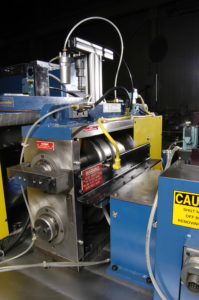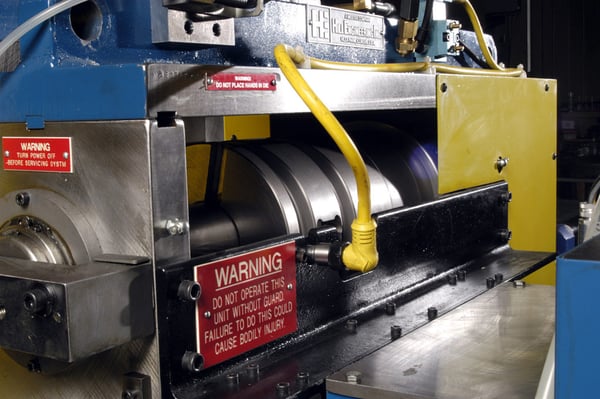Rotary Punching
The time has now come in the development of rotary punching machinery when many of the required perforated, slotted, tabbed, louvered, punched, or embossed patterns can be done using the rotary technique.
Rotary punching means that any of the above operations can be done by using a mating set of rolls, the diameter of which depends on the length of the pattern or multiples of patterns to be punched.
Construction:
 The rolls are made of either prehardened steel or tool-steel hardened. The type of material used depends on many factors, the most important being the speed that the unit must run, the gauge material to be punched and the longevity required of the unit (low, medium, or high production).
The rolls are made of either prehardened steel or tool-steel hardened. The type of material used depends on many factors, the most important being the speed that the unit must run, the gauge material to be punched and the longevity required of the unit (low, medium, or high production).
If at all possible (depends on the pattern to be punched), the rolls should be bushed. Even though this takes extreme measures at times, the unit can then be sharpened without losing diameter size and, therefore, pattern length. Louvers, shear-formed “loops”, slots (which can be punched on their sides only into discs) cut against the disc on each side of the slot and cut in the air, on its ends, and therefore need no bushings. Some stamping and embossing operations do not need, or cannot use, bushings, either.
There must be hardened alignment rolls (male/female) to keep the punch and die alignment 90 degrees to stock travel.
The gears are usually very critical to a successful operation of the unit when there must be accurate punch-to-die alignment in the direction of the rotary motion. In these cases, the gears should be hardened for wear, and precision ground or wire EDM’d, when punching material thicknesses under .062 inches. This statement is very general and is only given as a rough guideline.
An anti-backlash gear (split gear) should be used in most cases. This not only ensures that the alignment is maintained, but also ensures that you will obtain an increased life of all components in the rotary unit because of decreased chatter.
In all cases, be sure to use a large enough diameter shaft to ensure little or no deflection.
The bearings should be Timken tapered roller bearings.
Features that are extremely helpful, mostly in setup, are as follows:
- Fine adjustment mechanism to precisely adjust alignment between the punch and die.
- Some kind of pilot or alignment pin to ensure that there is no shearing of punches and dies during setup.
- An easy method for removing punches in assembly.
Operation:
Rotary units are operated any one of four different ways:
- The rotary unit has its own drive system and operates faster than line speed. It generates a free loop between it and the roll former and is turned on and off with a loop control on its exit side.
- The rotary unit has no drive system at all. The unit is rotated by virtue of the punches entering the stock continuously, or the rolls pinching on the stock continuously and the stock being pulled by the roll former.
- A combination of the two choices above. A drive unit is used with an overriding clutch in order to start up the unit without snapping the material and then, as the roll former picks up speed, the overriding clutch allows the roll former to provide the power and requires no more power input from the rotary motor no matter how fast the roll former is running.
- If the unit does not have its own drive, the strip is usually hand cranked through the rotary puncher and up to the roll former in order to start up the line.
The roll assembly can be operated either in its own stand or mounted in one of the stands on the rollformer. If it is mounted in one of the roll former stands and if the rotary puncher is a precision punching unit, that stand must have its gears detached so that the stand shafts are free wheeling. Then, the roll unit must always have its own set of gears attached to the rolls. If you do not do this, there could be shearing of the punches and die buttons and there might be buckling of the material in the roll former.
Advantages of Rotary Punching Include:
- Increased line speeds because you are not restricted by feed and press speeds.
- Decreased equipment costs because you no longer must pay for high-speed presses with sophisticated feeds.
- Decreased noise and vibration due to the natural shearing motion through the stock.
- Less floor space required because of their compact size and lack of a feed system.




